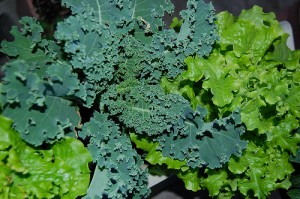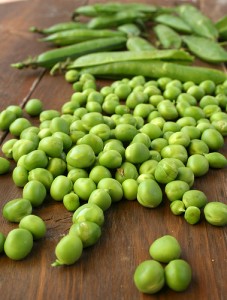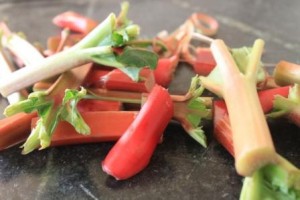Do you know what seasons your foods are from?
It is 70 and balmy here today in the Garden State. I am itchy to get outside, take a walk, and make something really healthy for dinner. Weather like this inspires me to begin spring cleaning… and this year it’s beginning… with me!
 It’s been a long, cold, stressful winter. I’ve eaten my share of diner and Chinese take-out meals as a consequence of going through the decline and death of my father. Today I yearn for the clarity and purification of spring, through the tonic of tender bitters like arugula or upland cress, a clean bowl of short grain brown rice, the grounding of shitake mushrooms, and some perky steamed kale and sweet beets.
It’s been a long, cold, stressful winter. I’ve eaten my share of diner and Chinese take-out meals as a consequence of going through the decline and death of my father. Today I yearn for the clarity and purification of spring, through the tonic of tender bitters like arugula or upland cress, a clean bowl of short grain brown rice, the grounding of shitake mushrooms, and some perky steamed kale and sweet beets.
What about you? It doesn’t take a family loss to pack it in through the long cold winter months. It’s natural to eat heavier, denser, and more caloric foods to keep us warm and energized through winter. Today I want to discuss the value of eating with the seasons, and the virtues of a little spring cleaning.
I first became connected with seasonal food 30 years ago, without even trying. I fell deeply in love with organic vegetable gardening and it became a passion that connected me to the cycle of seasons. It deepened my appreciation of supermarket produce isles; because I knew just how much time it took to grow one small pea (55-80 days, seed to harvest). Now that I’m 55 and so “busy with life,” it’s sometimes easy to forget all this, and a perfect Spring day like today wakes me back up.
It is true that humans eat all types of food, because they live everywhere. FOOD IS LIFE (in the pure and natural sense), and life eats food. But people in the tropics have a very different diet than the Eskimos, and for good reason! A steady diet of whale blubber would kill people living in hot, humid weather, where humans need more watery, cooling foods. But in the severe, harsh cold of the Arctic, whale fat is not only appropriately caloric, it’s insulating – and that makes it a life-saver.
 As a broad guideline, what we eat ought to come from the general climate zone we live in. In this way we become subtly synchronized to the rhythms of our seasons and climate. Why is this valuable? Aside from considering the footprint our purchases make (discussion for another article), natural whole foods are inherently healing, and by sensing their qualities, we can create greater internal balance through our food choices. This exists on the continuum from gross to subtle awareness, and is cultivated through time by paying gentle attention and being playful. A meal that is loaded with cheesy sauce, fatty meat and fried vegetables will yield a different digestive and energetic response than the one I mentioned at the start of this article.
As a broad guideline, what we eat ought to come from the general climate zone we live in. In this way we become subtly synchronized to the rhythms of our seasons and climate. Why is this valuable? Aside from considering the footprint our purchases make (discussion for another article), natural whole foods are inherently healing, and by sensing their qualities, we can create greater internal balance through our food choices. This exists on the continuum from gross to subtle awareness, and is cultivated through time by paying gentle attention and being playful. A meal that is loaded with cheesy sauce, fatty meat and fried vegetables will yield a different digestive and energetic response than the one I mentioned at the start of this article.
Cold weather invites contractive methods that comfort, warm and fortify us: baking, slow-simmered stews and soups, and pressure-cooking. Have you noticed that cool weather vegetables are the more compact or downward growing roots and tubers such as: carrots, kale, broccoli, beets, parsnip, yams, collards? They can not only weather a frost, they actually taste sweeter afterwards and they bring us vitality in the winter.
Warm weather uses more expansive cooking methods that help you lighten up and relax. When it’s super hot and humid in NJ, I cook so simply – light steaming, or not at all. (Yes, the culture of the “Grill” is another option, perhaps another article as well.) Warm weather vegetables grow upwards and have a higher water content that enables them to thrive in the heat; thus we can stay cooler by emphasizing these in our summer diet: cucumbers, tomatoes, summer squash, sweet corn, leaf lettuce, green beans.
 Spring and autumn are transitional seasons between the extremes of winter and summer, when our cooking styles and foods might vary most. As we care for our cars with regular oil changes and tune ups, we can follow Nature’s design to provide clues for what tunes up and cleanses our body in spring. Think GREEN, and you’re on your way to a little purification.
Spring and autumn are transitional seasons between the extremes of winter and summer, when our cooking styles and foods might vary most. As we care for our cars with regular oil changes and tune ups, we can follow Nature’s design to provide clues for what tunes up and cleanses our body in spring. Think GREEN, and you’re on your way to a little purification.
Everything is expanding and bursting outward and upward and that is good energy for us. Sprouts, bitters like arugula and watercress, steamed leafy greens, asparagus, and yes – if you can get them – spring peas! Radishes, leeks, and green onions, are in abundance now, and according to Chinese medicine, dissolve fat and excess mucus.
Why not consider welcoming in spring with a few days of lighter foods and less fat; try red lentils, garbanzo beans, eat lean chicken or cold water fish, whole grains like quinoa and brown rice, and less sugar. Drink water with fresh squeezed grated ginger and lemon for a cleansing gall bladder and liver tonic.
Join me for some more Spring Cleaning:
What 3 changes do you know would be good for you to make regarding food?
What 2 changes for your lifestyle?
What 1 change for your mental health and overall well being – your spirit?
“Everything’s coming up roses and daffodils.” Keep me posted.
__________________________________
Photo Credits: Lettuce – Will-travel, Peas – Dayna McIsaac, Rhubarb – thegardenbuzz (Used with permission under Creative Commons license.)


Hi Maryann!
you can also just peel the ginger with a carrot peeler, slice it and steep it in a teapot of hot water & squeezed lemon. In summer – fresh mint added tastes wonderful. Thanks for your post.
I am absolutely going to “drink water with fresh squeezed grated ginger and lemon.” I never would have thunk that this could combine, but it sounds delicious!!!